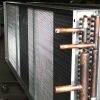As a building owner or manager in New York City, you are likely aware of the requirements set forth by Local Law 97, also known as the Climate Mobilization Act. This groundbreaking law, which was passed in April 2019, is a crucial component of Mayor de Blasio’s plan to make New York City carbon neutral by 2050. The law aims to reduce greenhouse gas emissions from the city’s buildings by 40 percent by 2030 and 80 percent by 2050. This article will focus on how building owners and managers can meet the requirements of Local Law 97, specifically concerning heat exchange coils and fan array systems.

One important aspect of Local Law 97 is the requirement for buildings over 25,000 square feet to meet new energy efficiency and greenhouse gas emissions limits by 2024. These limits will become even stricter in 2030. To comply with these requirements, building owners and managers will need to assess and upgrade their HVAC systems, including their heat exchange coils and fan systems.
Heat exchange coils are a critical component of HVAC systems. Old or damaged heat exchange coils can result in reduced energy efficiency, which can contribute to higher greenhouse gas emissions. Building owners and managers should ensure that their heat exchange coils are functioning properly and consider upgrading to more energy-efficient models if necessary.
Fan systems are also an important part of HVAC systems, as they help to distribute heated or cooled air throughout the building. Like heat exchange coils, fan systems can become less efficient over time, resulting in increased energy consumption and higher emissions. Building owners and managers should consider upgrading their fan systems to newer, more energy-efficient fan array systems state-of-the-art fan speed control systems to optimize the efficiency of their HVAC systems.
In addition to these considerations, building owners and managers should also review the Local Law 97 Covered Buildings List, which is released by the Department of Buildings (DOB), to determine if their properties are subject to the law’s requirements, and familiarize themselves with the proposed rules and guidelines issued by the Department of Buildings. The Department of Buildings has also released a Greenhouse Gas Emission Reporting website which provides information on emissions limits and buildings that are exempt from Local Law 97 requirements. Additionally, the City approved a budget that includes $2.4 million for the DOB Office of Building Energy Emissions Performance to oversee the implementation of Local Law 97.

By upgrading their heat exchange coils and fan array systems and staying informed about Local Law 97 requirements, building owners and managers can help to reduce greenhouse gas emissions and contribute to the city’s goal of becoming carbon neutral by 2050. It’s important for building owners and managers to take these steps as soon as possible, since Local Law 97 will have a big impact on energy consumption, emissions and also the cost of running a building, if not addressed on time. The Department of Buildings has several resources available to help building owners and managers understand their responsibilities under Local Law 97, so be sure to consult the department for guidance and assistance.
Ready to upgrade your building’s coils and fans? Let us help.





